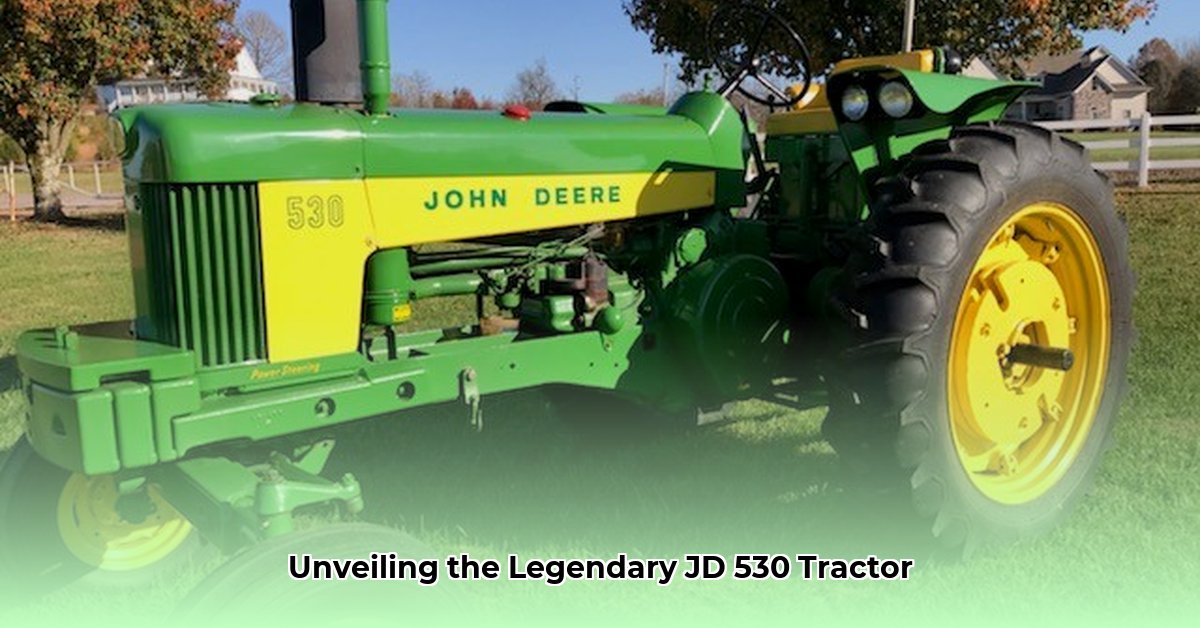
A Piece of Agricultural History: The John Deere 530
The John Deere 530. The name alone evokes images of hardworking farmers and a bygone era of American agriculture. Produced between 1958 and 1960, this isn't just a tractor; it's a collectible, a piece of history reflecting John Deere's legacy and the evolution of farming practices. Approximately 9,800 of these robust machines were manufactured, leaving an enduring mark on the agricultural landscape. But what made the JD 530 so special, and what's it worth today? Let's delve into the details. This comprehensive guide will equip you with the knowledge to appreciate, restore, and value this iconic machine. For more on similar models, check out this Case 530 specs.
Detailed Specifications: Understanding the JD 530's Capabilities
The JD 530 was a powerful machine for its time, boasting a range of features designed for efficiency and versatility. The technical specifications below, based on data from reputable sources like TractorData, provide a clearer understanding of its capabilities. Note that specific specifications may vary slightly depending on the individual unit.
| Feature | Specification | Notes |
|---|---|---|
| Manufacturer | John Deere | Known for its quality and reliability. |
| Model | 530 | An iconic model in John Deere's lineup. |
| Production Years | 1958-1960 | A relatively short, but impactful, production run. |
| Estimated Units Produced | Approximately 9,800 | A substantial production run, indicative of its popularity. |
| Original Price (USD) | Roughly $2,400 (1960) | A significant investment, considering inflation. |
| Engine | John Deere 3.1L 2-cylinder (gasoline, all-fuel, LP gas) | Offered versatility in fuel choices to meet diverse needs. |
| Fuel Tank Capacity | Varied by fuel type (see details below) | Gasoline: 18 gal; All-Fuel: 15.5 gal; LP Gas: 33 gal |
| Transmission | 6-speed unsynchronized | Unsynchronized transmissions required careful matching of engine speed during gear shifts. |
| Drawbar HP | 33.3 | Horsepower at the drawbar, indicating pulling power. |
| Belt HP | 37.52 | Horsepower at the belt pulley, for powering equipment. |
| Drive Type | Two-wheel drive | Common for tractors of this era. |
| Brakes | Differential mechanical expanding shoe brakes | A simple yet effective braking system for its time. |
| Weight | Approximately 4960 lbs | Significant weight provided stability and traction. |
| Serial Number Range | 5300000 - 5309814 | Useful for identifying and tracing individual tractors. |
Isn't it fascinating to see the technological advancements in agricultural machinery since 1960? How much more powerful are today's tractors?
Production History and Market Analysis: Value and Rarity
The JD 530's relatively short production run (1958-1960) contributes significantly to its collector appeal. Similar to limited-edition vehicles, scarcity increases desirability and, consequently, value. Determining the precise number of surviving JD 530 tractors is challenging. However, its original price of roughly $2,400 (1960) gives us a starting point for assessing its current worth. Several factors heavily influence the current market value:
- Condition: A meticulously restored JD 530 in pristine condition will command a much higher price than a neglected or incomplete machine. A fully restored tractor can easily command a premium.
- Rarity: Specific variations or options might be more sought-after by collectors, increasing value.
- Parts Availability: The availability of original or reproduction parts significantly impacts restoration costs and, therefore, value. Finding parts for older machinery can be a challenge. Websites specializing in classic tractor parts are a good starting point..
- Market Demand: Current market trends and collector interest also play a role in determining the current value.
While precise auction data for JD 530s isn't readily available to the public without paid subscriptions to sites like TractorHouse, these factors are essential considerations when assessing value.
Restoration and Maintenance: Tips for Collectors
Restoring a JD 530 is a rewarding but demanding project. It requires patience, mechanical aptitude, and access to resources. Sourcing parts can be a significant challenge. Online forums dedicated to John Deere tractors often prove invaluable for locating parts, techniques, and advice. While comprehensive restoration manuals might be scarce, the collaborative spirit within these online communities ensures support and guidance throughout the restoration process.
Connecting with the Collectors' Community: Sharing Knowledge and Resources
The passionate community surrounding classic tractors is a valuable resource. Numerous online forums and clubs dedicated to John Deere equipment offer an excellent opportunity to connect with other enthusiasts. These online communities provide a platform for sharing restoration tips, parts sourcing strategies, and invaluable insights into market values. Engaging with this community is a guaranteed way to enhance your restoration project while connecting with like-minded individuals.
By engaging with these resources, collectors can ensure the ongoing preservation of this significant piece of agricultural history. The JD 530 is more than just machinery; it's a testament to innovation and the enduring legacy of John Deere.